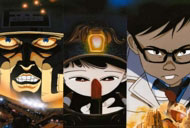
Manie Manie
In as short a description as I can muster, Manie Manie is The Twilight Zone of anime.
Although many anime have odd or strange elements to them, very few films go to this length to present new, bizarre worlds that defy categorization. So, at best, what I can do is describe the three segments that make up Manie Manie--which was also given the title Labyrinth Tales in Japan, as I understand it--and then try to make some sense out of the jumble they present. Now don't misunderstand me. I found Manie Manie to be a fascinating work, but it is certainly as confused and bizarre an art film as I've seen in recent memory.
The show bookends itself with "Labyrinth", a fantasy about a young girl who, with her curious and rather hefty cat, finds a strange world of dark clowns and strange spirits. Entering this mysterious place through a mirror, not unlike Alice in a Lewis Carroll story, she doesn't have a story so much as an experience in this neverland. In the middle, we are confronted with "The Running Man," a far more straightforward tale about a race car driver who's hardly involved with the runs he makes due to the fantastic technology around him. When he starts pushing himself to the limits to actually see if he can win the race himself, bizarre things start happening. Finally, the show comes to an end (save for the short reprise of "Labyrinth") with "The Order To Stop Construction." A young salaryman is sent into the jungles of Brazil where his company is making a city created entirely by robots. He's supposed to oversee the project, but when he arrives, he finds the entire place in disarray. Turns out the robots have become at least somewhat sentient, and they realize that stopping construction might mean the end of their existence--and we find out what lengths they are willing to go to so that the order to stop construction is never fulfilled.
In many respects, Manie Manie does indeed resemble The Twilight Zone. After all, in Rod Serling's spooky series, the stories themselves were in no way related except that they dealt with the fantastic, strange, supernatural, and otherwise outlandish. Manie Manie's stories are not interconnected, as some other anime "short story compilations" like Robot Carnival are. What is also similar is that you have three anime directors who are now extremely well-known contributing the short stories, not unlike Joe Dante, John Landis, and Steven Spielberg directing segments of the Twilight Zone movie. Whether or not there is any inspiration at play here is up for grabs, but it is an interesting comparison.
But let's get into the heart of how the movie works. Rin Taro directed "Labyrinth", and though many may disagree with me, I actually found this to be one of the most interesting films he's done. Rin Taro has directed, in my opinion, some of the worst anime ever, in particular Harmagedon and X; nevertheless, he is extremely popular. His general problem is that he cannot stay focused on his stories, and he often winds up boring the audience to tears while he overwhelms us with pretty pictures; even his best work, The Dagger of Kamui, has pacing issues. Here, he has no real story at all to have to deal with and a short amount of time in which to work, so he ably creates a haunting yet strangely enjoyable world around this little girl who falls through the mirror. Because he plays with what he does best, I feel he succeeds. (Some who aren't familiar with Rin Taro's work might still find this a bit dry; those who are will be stunned by the lightning speed of this work in comparison to the rest of his portfolio.)
Meanwhile, Yoshiaki Kawajiri shows up as director of "The Running Man". The artistic style he employs here is not all that dissimilar from what he would use two years later in the gruesome sci-fi/sexual-horror cult classic Wicked City, and it works very well. There is a problem with this segment, however--the story is told in a linear fashion, but we're not sure exactly what we're seeing. When our hero driver starts to lose it, we think perhaps he's dead, but he keeps driving...what is going on? The story never quite answers our questions and winds up merely ambiguous. Although one could make the same argument for "Labyrinth", that piece seems intentionally artistic; this one just doesn't work on every level. I still liked it, but I wasn't stunned. Because Kawajiri is also responsible for the fanboy hit Ninja Scroll, some might seek this out, but they will be sorely disappointed.
"The Order To Stop Construction" is by far the easiest of the three stories to understand and enjoy, and it's by the name virtually every American anime fan knows: Katsuhiro Otomo. The creator of Akira continues to establish his credibility here, and certain parts of the design are reminiscent of the cyberpunk classic. However, it also is reminiscent in form of Otomo's work on the afore-mentioned Robot Carnival. What's nice about this segment is that it's easy to follow, nicely animated, and grimly amusing throughout. Even if you can't stand the other segments, you should still give this one a try, especially if you want to see some of the artistic styles in Akira floating around in earlier form.
It would be easier, perhaps, to rate the segments individually, but that really isn't fair, since they are intended to be seen together. For the anime lover, Manie Manie handsomely showcases three expert directors doing short art films. For the casual viewer, Manie Manie may just be a little too dark and esoteric to be of great interest. I thought it was a good blend, a little weak at times but always intriguing and often entertaining. Not quite an A list title, but very close indeed.
Manie Manie -- violence, disturbing imagery -- B+

